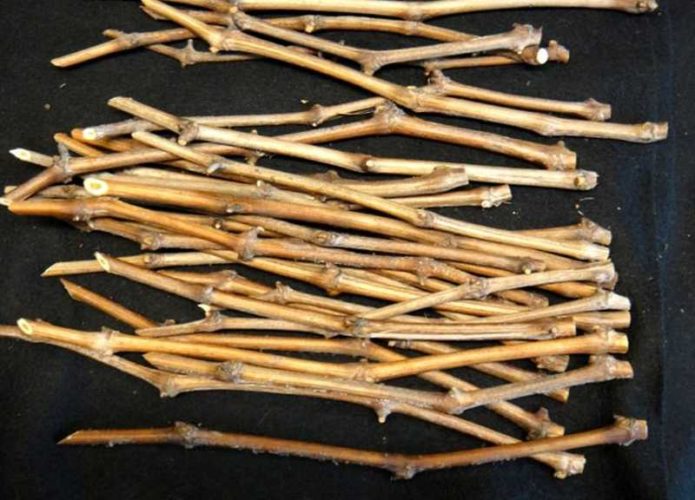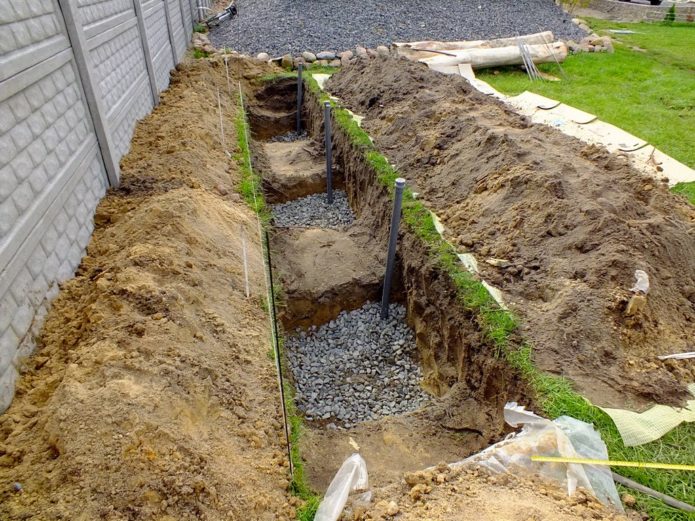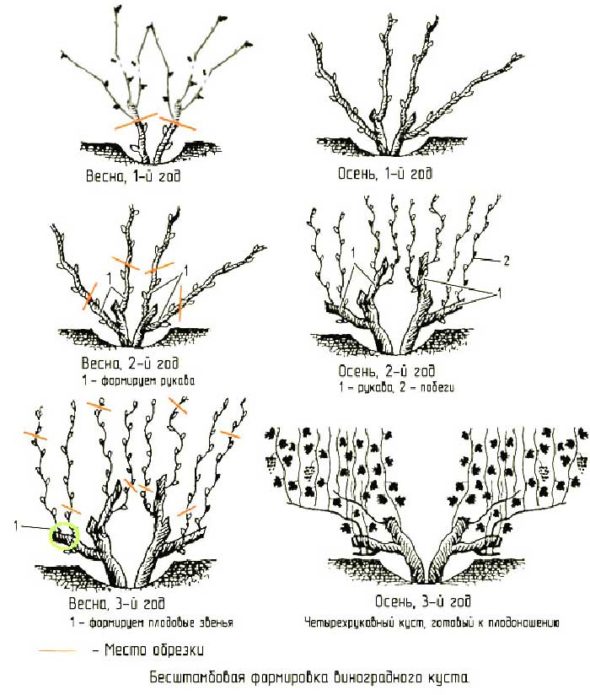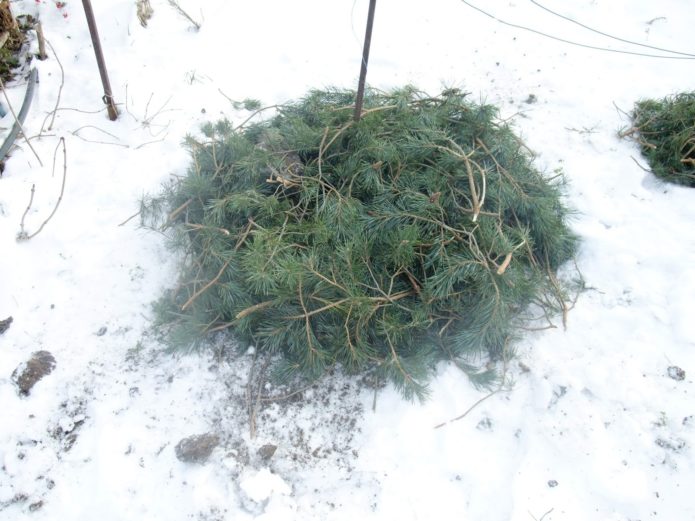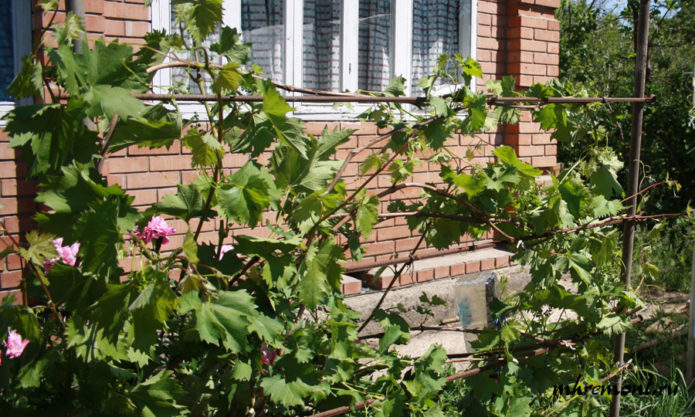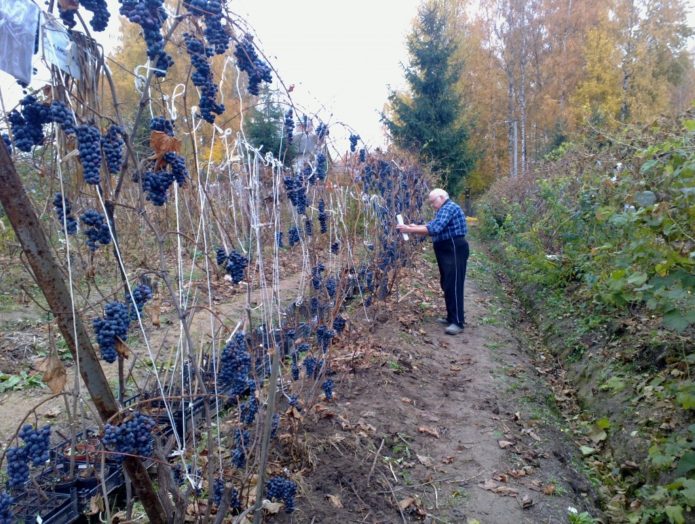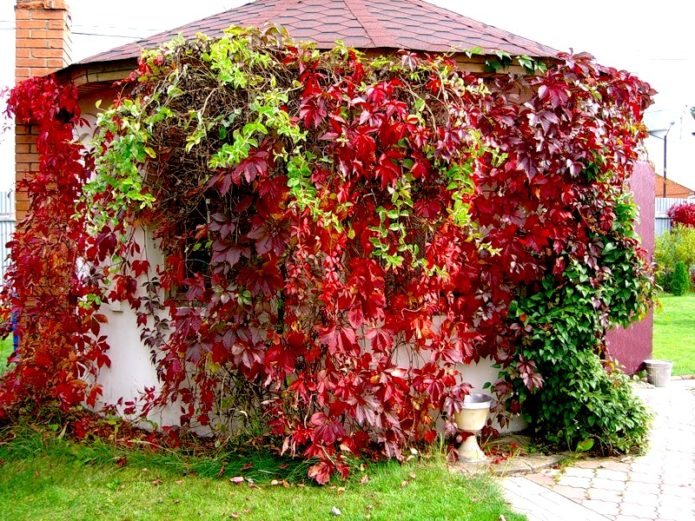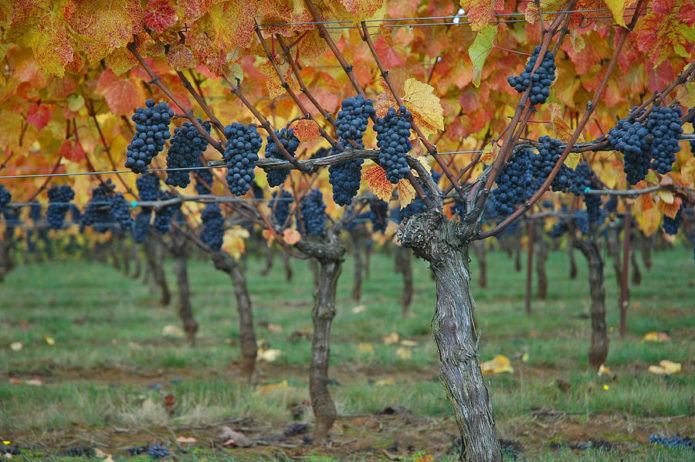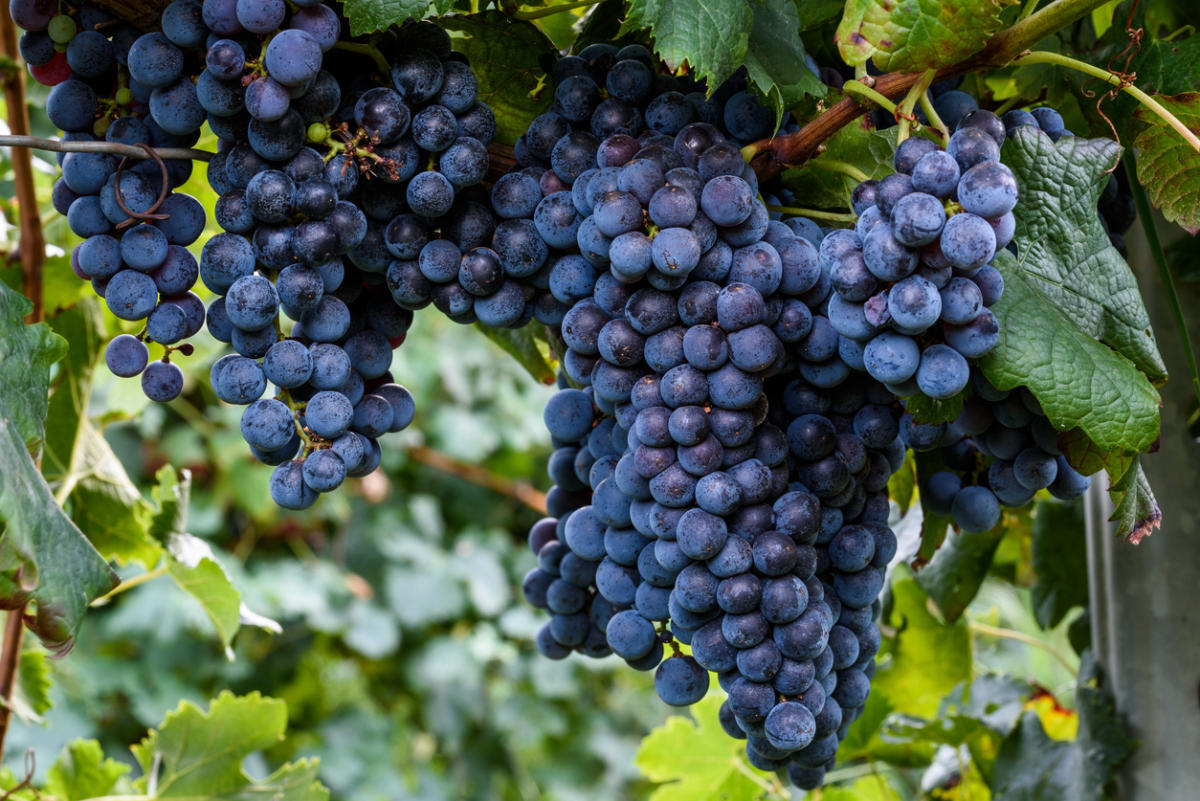Grapes in garden plots in the middle zone of our country can be found more and more often. The achievements of breeders and the enthusiasm of summer residents are doing their job, and the southern vitamin berry "just from the garden" is now a frequent guest on the tables of those regions where it was impossible to think about it before. A vineyard in the country requires the application of strength, but its establishment and maintenance are not insurmountable difficulties.
Content
Growing grapes in the middle zone of Russia
For the successful cultivation of grapes in the middle zone, one must understand the peculiarities of the life of this southern plant.
- Grapes need sunlight. With its lack, you cannot get good berries.
- Grapes love warmth. For normal growth and formation of the crop in summer, temperatures are needed at least 20 ° C. Grape leaves freeze at –1 ° C, and even perennial wood perishes when frosts are stronger than –25 ° C.
- Grapes are a drought-resistant crop, but with justified watering, the yield increases several times.
If earlier newcomers to viticulture were offered to start with planting Lydia or Isabella, now this advice, even in the middle lane, can hardly be called correct. Rather, on the contrary, the taste of Isabella, who goes only for wine, can be discouraged from such an interesting activity. And growing many varieties with very tasty berries, especially early ones, is a little more difficult. Any novice winegrower with basic gardening skills can handle this.
Growing grape seedlings in the conditions of central Russia
The most common method for propagating grapes is from cuttings, it is quite feasible in the conditions of central Russia. Cuttings are cut from strong annual shoots during autumn pruning of vines... Shoots should be at least 5 mm thick, any length for autumn cutting: it is convenient to take 30–40 cm each. Each should have 4–5 well-developed buds. Until February, cuttings are stored in a cellar or refrigerator in loosely tied plastic bags at a temperature of about 0 ° C.
In February, cuttings are taken out and cut into pieces with 2-3 buds. The upper cut is made straight, 2–3 cm above the kidney, the lower slanting 1–2 cm under the kidney.Chopped cuttings are soaked in water for a couple of days. After that, several longitudinal scratches are made in the lower part of the cuttings to facilitate root formation.
The best grape varieties for central Russia:https://flowers.bigbadmole.com/en/yagody/vinograd/sorta-vinograda-dlya-sredney-polosyi-rossii-s-foto-i-opisaniem.html
Cuttings can be planted in any liter container with a substrate, but most conveniently - in plastic bottles with a cut off top and holes in the bottom to drain excess water. Any light soil (sand with soil, sand with peat, pine sawdust, etc.) is suitable as a substrate. The stalk is planted so that one bud remains on the surface. It is poured over with a pink solution of potassium permanganate and for the first time covered with a plastic bag.
Containers with cuttings are placed in a warm place (25-28 ° C). When the first leaves appear, the stalk is gradually accustomed to being without a bag. Good light is definitely needed at this time. After another 3-4 weeks, you should try to pull the stalk out of the substrate. If it holds on tightly, then the roots are already there.

When several leaves have appeared on the cuttings, they may already have roots, but this should be checked
Cuttings are systematically watered with settled water, fed twice with complex fertilizer. For the rest, the main thing in care is compliance with temperature and light conditions. A rooted cutting will become ready for planting in a permanent place as a young seedling by summer.
In the retail network and in the markets, older seedlings are more often sold, which have already lived in the open field for a year and have grown both above-ground shoots and a good root system. Such seedlings are usually sold without a clod of soil, and when buying, you must carefully monitor that the roots are alive and healthy.
Storage of grape seedlings and preparation for planting
The best time for planting two-year grape seedlings in central Russia is the end of April. If they were bought with an open root system, but they cannot be planted right away, they must be properly preserved. At least, wrap in a large wet sacking: so, in a wet rag, they will last a week and a half. In the same state, the seedlings must be taken to the country. If you have to wait several days for planting, you can simply dig them into damp ground.
Before planting, it is necessary to remove all the upper roots, if any, and leave the roots only on the heel itself, cutting off and broken. The seedlings must be soaked for one or two days in water, or better in a weak urea solution: 1 tablespoon in a bucket of water, placing both the roots and the vine in the solution. Immediately before planting, the roots are dipped in a mash made of clay, mullein and water.
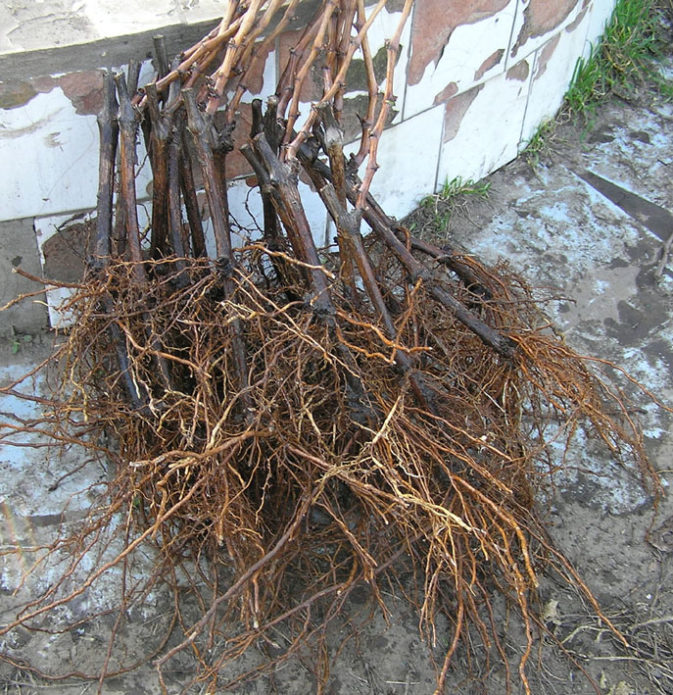
Second-year seedlings have very powerful roots, but before planting, it is better to remove some of those on the trunk
If we are talking about planting a self-grown seedling in a container (pot, bottle, etc.), the conversation is somewhat different. They will have to be planted only at the beginning of summer, and before that time it is necessary to have time to harden them, taking them out to the balcony on not too cold days. It is necessary to bring the pots with seedlings to the dacha on the day of planting, and just water well before planting.
All about planting grape seedlings. Site preparation, planting depth and scheme, fertilization and watering:https://flowers.bigbadmole.com/en/yagody/vinograd/kak-posadit-vinograd-vesnoy-sazhentsami.html
Choosing a place for grapes on the site
Grapes can be planted both on level ground and on not very steep southern and southwestern slopes. Dangerous placement in lowlands and on the northern slopes: damage to fruit buds is possible by late spring frosts. The grapes grow on any soil, except for very wetlands and areas with close groundwater. For planting grapes in central Russia, you need to choose the sunniest areas, well protected from winds, especially northern ones.
All common fruit trees are good precursors for grapes. It cannot be planted only in the place where grapes have already grown before; after uprooting the grape bushes, vegetables, flowers or herbs should be grown in this place for several years. Most often grapes are planted after vegetables, but it is better to sow siderates - oats, vetch, mustard in the last year before planting grapes.
Almost anything can be planted next to grapes, and its most beloved neighbors are peas, onions, beets, strawberries, cucumbers, sorrel. Not very fond of grapes next to tomatoes and corn. Competing for water and nutrients with horseradish.
Surprisingly, grapes do not tolerate being close to marigolds growing even at a distance of 5–6 meters.
Soil preparation and planting pit for grapes, fertilization
Long before planting the grapes, the soil must be carefully prepared. Since in the conditions of central Russia, grapes are planted almost exclusively in the spring, this should be done in the fall. Pre-planting soil preparation at the summer cottage consists in digging onto a shovel bayonet with the simultaneous application of fertilizers. In advance, before planting, they enrich the soil around the future bush with rotted manure, phosphorus and potassium fertilizers. Of course, they are also brought into the landing pit.
When digging, it is not necessary to throw out pieces of bricks and small stones from the ground: grapes love stony soils.
In the conditions of central Russia, it is better to dig a hole not far from any buildings that block the grapes from the cold northern winds. A large pit is being dug: its dimensions are at least 80 × 80 × 80 cm. There are different approaches to filling the pit. In the conditions of the middle lane, it is necessary to force the grapes to take root as deeply as possible, and for this you can apply a little trick: make a small obstacle to the nutrient layer with fertilizers. To do this, a well-mixed mixture of humus, sod land, sand and mineral fertilizers must be laid on the bottom of a deep hole with a layer of 20–25 cm. You can take a complex fertilizer - for example, nitrophoska, 400 grams, and the rest of the mixture components in approximately equal volumes. The second layer, ten centimeters, must be made of drainage: rubble, broken brick, slate fragments, etc. Through this barrier, the grapes will let their active roots in search of nutrients.
The entire space above the drainage will be covered with soil mixed with humus during planting (approximately 3: 1). On very acidic soils, a couple of handfuls of slaked lime can be added to this mixture. You cannot fertilize this soil too much - young roots will be damaged. But it is not necessary to cover the soil before planting a grape seedling. It will be necessary to bury the seedling in the conditions of central Russia deeply, placing it almost on the drainage layer. And beforehand, a couple of buckets of water can be poured into a pit filled with fertilizers and drainage.
If several bushes are planted at once, you need to know about the distances between them. For low-growing varieties, the minimum distance between bushes in a row should be 1.3-1.5 m, for medium-growing ones - 1.5-2 m, vigorous ones - from 2 to 3 m.
Planting and transplanting grapes in central Russia
You should immediately agree on which seedling you are holding. If this is a two-year-old with powerful bare roots and still without leaves, then it is still early spring. It should be planted in the middle lane in April. If this is the seedling that was a cutting back in February, you grew it at home yourself, and it is in a container, covered in leaves, then it will need to be planted only at the beginning of June. Autumn planting of grapes in the middle lane is possible, but undesirable.
Before planting grapes in a prepared hole, you need to try them on. It will have to be in the hole so deep that only 1-2 buds are visible from the ground.Therefore, it is necessary to pre-pour so much of a mixture of soil with humus so that the seedling, placed with the heel on the bottom, looks out. In advance, you need to drive in a stake for a garter of an intensively growing vine, as well as a piece of a solid inch pipe through which the first 1-2 years will need to water the seedling to the very roots. If there is enough rainfall in the region, and the soil is light, permeable, the pipe is not needed. Then a small mound is poured and a grape seedling is planted. If this is a strong seedling with an open root system, it is planted like ordinary bushes: set on a mound, spread the roots, fill the hole and water it well. If this is a very young seedling, grown at home from a cuttings, you should try to plant it with a lump of earth, carefully removing it from a home container. Such a seedling can be planted higher so that several leaves can be seen from the ground.
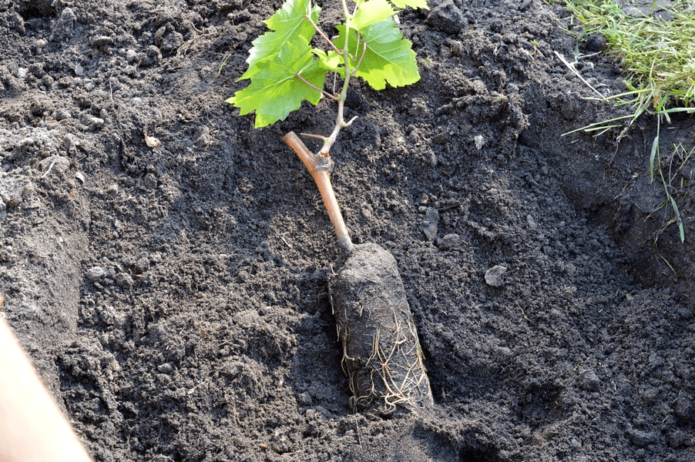
A seedling grown from a cuttings in the spring must be planted with a clod of earth, trying not to damage it
If it was necessary to transplant a grape bush, it is quite difficult to do this, and if the bush is more than 5 years old, it is almost unrealistic. Younger bushes can be transplanted in the middle lane, but only in early spring. The older the bush, the larger clod of earth you should try to leave on the roots. The transplanted bush must be well pruned, and a few days before digging up, water abundantly, despite the fact that there is still enough moisture in the soil in the spring. The bush should be dug so as to damage the minimum of the roots, that is, dig a circular trench far from the center of the bush. The roots sticking out of the remaining coma are cut off. A lump is wrapped on all sides with a strong rag, a strong sheet of any material available in the household is placed under the bottom and the lump is taken out. In a new place, the bush is very well watered and mulched.
Grape care, feeding and treatment against diseases and pests
Having planted grapes on a site in central Russia, one must realize that now there will be a lot of work. True, most of the trouble is quite accessible to an experienced gardener, but new knowledge will also be required. Not everyone can visit the site all year round, but there is work in the vineyard in winter. Basically, these are insulation measures: throwing snow on the bushes sheltered for the winter. And the main work begins with the arrival of spring, in the middle lane - around the end of March.
At this time, it is necessary to open the bushes wrapped for the winter. If possible, apply basic fertilizers by burying them in shallow holes. In mid-April, the vines can already be lifted and tied to the trellis. When the thermometer reads through 0, you can spray the grapes with nitrafen or Bordeaux liquid. At the end of April, tie up the vines, distributing them along the stretched wires. In May, in the middle lane, grapes begin to wake up, but the processes on it go very quickly: buds soon open, leaves appear, and flowering begins. As soon as the intensive growth of young shoots has begun, the extra ones must be immediately broken out, without waiting for them to grow large and shade the growing berries. At the end of May, you can give the bushes a liquid top dressing.
Where to start, how to avoid mistakes, in what sequence to open grapes when using a certain shelter option:https://flowers.bigbadmole.com/en/yagody/vinograd/kogda-raskryivat-vinograd-vesnoy-posle-zimnih-ukryitiy.html
In the summer, as they grow back, they tie up new shoots, remove unnecessary stepsons and bunches. It is imperative to feed the bushes during the growth of berries, which is most conveniently done by spraying the leaves with solutions of complex fertilizers. August dressings should no longer contain nitrogen. In mid-August, the harvest of early varieties ripens.
September is the main harvest month. If the yield is very large, foliar dressing with phosphorus-potassium fertilizers is required. If there are signs of disease, and the berries have not yet been harvested, the bushes are sprayed with sulfur preparations or potassium permanganate.After the autumn frosts and leaf fall, the main pruning must be done. After pruning, the vines are removed, tied in bunches and covered for the winter. In dry weather, water recharge irrigation is carried out. Shallowly dig up the soil around the bushes, introducing rotted manure.
Fertilizers have to be given to grapes systematically, starting from planting. Grapes consume a lot of potassium, so potash fertilizers, preferably wood ash, can be used in maximum doses. In autumn, manure and compost are buried under the grapes, to which you can add superphosphate and ash. In spring, any fertilizers are used, including nitrogen ones. And two to three weeks before the beginning of flowering, several liter cans of ash should be poured under the bush, sealed to a depth of 10-15 cm and watered well.
In summer, foliar feeding is much more convenient, that is, spraying the bush with weak fertilizer solutions. They are held in the evening. The first such feeding is needed a week before flowering. For her, use solutions of complex fertilizers (for example, nitrophoska). The next dressing is after flowering, as well as with the beginning of ripening of berries. Solutions for dressing must be prepared strictly according to the instructions on the package.
Sometimes top dressing is combined with spraying with Bordeaux liquid to fight disease. In the case of a clear absence of diseases, it is better to use wood ash for preventive purposes. During the day, it is infused in water (a liter of ash per bucket). After that, filter it so as not to spoil the sprayer. If the grapes are clearly ill, it is necessary to study special literature: here you cannot do without powerful medicines, but it is better not to bring diseases to disease. As a rule, they appear only in a poorly maintained vineyard, where they do not pay due attention to fertilizing, watering, and the bushes are not properly cut.
Video: grapes in Nizhny Novgorod
Watering grapes in the middle zone of Russia
Fortunately, in most regions of central Russia there is usually no shortage of rain, so in other years watering is almost not required: the vineyard does not need extra water. Watering of young bushes is absolutely obligatory: in the year of planting they are watered several times with 4–5 buckets per bush, mulching after irrigation with humus or peat. For fruiting grapes in case of dry weather, even in the middle lane, watering is required immediately after flowering. But before flowering or during it, watering is unacceptable: the bulk of the flowers from excess water can crumble. A lot of water is required during the growth of berries, but watering should be stopped a month before harvesting. But in general, the roots of grapes penetrate deeply, and, if there was nothing unusual with the weather, in central Russia they will find their own water.
In almost any autumn, even in the middle lane, water-charging irrigation will not interfere. Without it, the soil freezes deeply, the icy earth spoils the roots. Podzimny watering is carried out after the leaves fall.
Pruning grapes in the middle zone of Russia
Pruning grapes is an art: it is more difficult to learn it than the art of pruning an apple or pear, and for this you need to study the relevant literature. Without knowledge, you cannot approach a grape bush with a pruner. Is that to cut out clearly broken and dead shoots. Pruning can increase the yield several times or, conversely, reduce it to a minimum, and the outcome depends on how skillfully it was done with hands. Pruning is not needed only in the first year after planting. The first few years can be pruned in early spring, and after entering fruiting, only in autumn.
Without going into the details of the methods of forming bushes, it is possible to recommend, without experience, only thinning pruning: cut out obviously unnecessary shoots thickening the bush. Their number also depends on the grape variety: some varieties are more successful when forming a bush in the likeness of a tree, while others give a dozen or more independent sleeves to grow from the base. Pruning is performed with a sharp pruner, the wounds are not covered with anything.Slices try to make at an angle of about 45about 1–2 cm above the kidney.
To facilitate the work of pruning, it is necessary to constantly break out excess green shoots in the summer, while they are very small. The bush reacts to their breaking almost painlessly, in contrast to cutting a ripe vine. Green shoots are removed by hand, breaking them off from the place of growth. Cutting should not be carried out only during flowering.
Correct pruning in the first 3-4 years should be aimed at obtaining the most illuminated bush, which makes it easy to take care of itself and gives a bountiful harvest of berries, each of which will have enough space and sunlight.
Preparing grapes for winter in the conditions of central Russia
In the middle zone of our country, almost all grape varieties have to be sheltered from frost for the winter. Without shelter, only semi-wild varieties can exist, which are usually grown for the sake of a hedge and in some cases for the preparation of simple wines.
Shelter for the winter is done at the end of October. Before the shelter, a thorough pruning of the grapes is carried out, removing also unripe shoots. After the first slight frost, they break, or even fall off themselves. They should be cut out to healthy, mature areas. After that, the vines are removed from the trellises and lightly tied into bundles so that it is easy to lay on the ground. It will be nice to whitewash the vines at this time, especially the lower parts.
Most of the new varieties bred for the middle lane can withstand frosts down to about -25 aboutC, so there is no point in wrapping the vines tightly. Nevertheless, many gardeners in the middle lane dig deep trenches for laying bushes and cover them with a large layer of earth in the trenches. In most cases, this is clearly unnecessary. At the same time, one must envy a good owner if he dug a trench next to the grapes, covered it with boards from the inside, puts the vines in the resulting box, covers it with boards, and fills the boards with spruce branches. This is ideal, but it takes time and effort.
If there is less enthusiasm, the bunches of vines should simply be packed more compactly, and covered with slate sheets, plywood, spruce branches, a thick layer of dry foliage, etc. The main keeper of heat for grapes is snow, and the shelter must be designed so that it can cope with the frost before a powerful snow cover is established. Wrapping up with old blankets, sweatshirts and other rags is bad: mice will start and gnaw the bark, the grapes will disappear. Mice are not that afraid of spruce needles, but they do not really like to inject. Better yet, put a special treat for them - poison. It is not necessary to wrap the vines in plastic wrap, as many summer residents do, in the middle zone: unlike Siberia, frosts here alternate with thaws, and the drying out of the bark during a thaw is no better than freezing.
Reproduction of grapes in the conditions of central Russia
A summer resident in the conditions of central Russia can only recommend one method for propagating grapes - using cuttings, as described at the beginning of this article. The guarantee that a good seedling will grow, subject to strict adherence to the rules, is close to 100%. And the difficulties in growing seedlings from cuttings are not great. All other breeding methods are either more difficult or do not lead to guaranteed success. These are ways such as:
- seed reproduction;
- reproduction by layering;
- grafting of grapes on grapes.
There is too much trouble with seeds, seedlings from cuttings are not obtained as quickly and not as powerful as from cuttings, but grape vaccinations they work worse than on fruit trees.
Methods of growing grapes in the conditions of central Russia
Grapes are essentially a liana, and to ensure a normal existence, they need strong supports.True, in dacha conditions, he himself is lazy to climb the supports, although most young shoots still cling to the tendrils of structures that come close to them. These are the structures on the site that need to be created.
Growing on a trellis
Trellis cultivation is the main method of forming a grape plant. It can be any structure consisting of vertical posts and horizontal supports. Recently, there are a variety of large mesh nets on sale: both metal and durable plastic. They can also serve as such supports. But traditionally, tapestries are arranged by driving strong posts or metal pipes into the ground. Different grape varieties have a bush of different sizes. There are also very powerful ones, for example, one of the new varieties in the middle lane Furshetny, for it the pillars can be three meters high, but usually they try not to create bushes above 2.5 meters for convenience. Therefore, the pillars must be of the appropriate size.
Several horizontal rows of wire are pulled between the posts. The lower tier is at a distance of 50 cm from the ground, the subsequent ones are every 30–50 cm. In the spring, overwintered vines are tied horizontally to the lower wire. Powerful green shoots growing in summer are tied up vertically, at the same time breaking out unnecessary ones. Leave 20-30 shoots per adult bush, depending on the variety, sometimes even up to 50. They monitor in time both the number of shoots and the mass of the future harvest, removing extra brushes.
Growing in a greenhouse
With the advent of frost-resistant grape varieties, greenhouse cultivation is slowly becoming a thing of the past, but it is still often used, including in the conditions of central Russia. Of course, grapes are not tomatoes, and the construction of greenhouses for such a large plant requires considerable investment, but when you want an early harvest, they go for this: most varieties ripen in a greenhouse two to three weeks earlier.
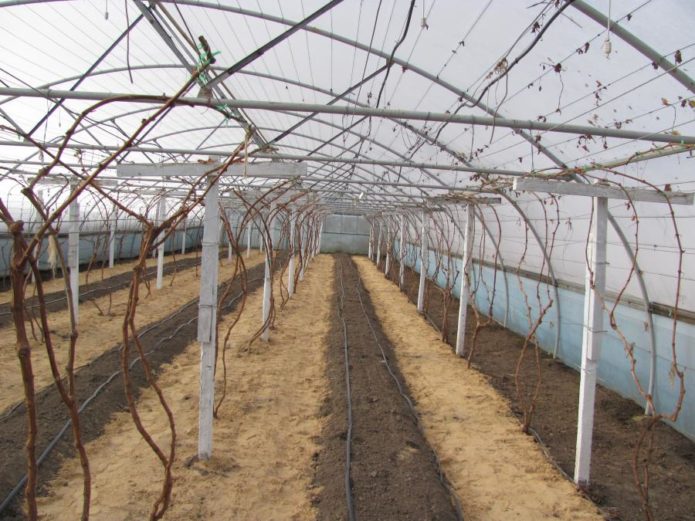
The device of greenhouses requires money and in the middle lane is more suitable for industrial cultivation of grapes
Bushes are planted in the greenhouse more often than in the open field: after 1-1.5 meters. The greenhouse protects the grapes from hail, unnecessary rain, light frost. We are talking, of course, about the unheated version. In the greenhouse, grapes are watered at least three times per season, combining watering with top dressing. They stop watering a month before the litter of the harvest, but they also carry out winter watering.
In summer, you have to ventilate the greenhouse, monitor the humidity. Shelter for the winter is also required in the greenhouse.
Benefits of greenhouse grape cultivation:
- guaranteed harvest;
- prolongation of the warm period, allowing the vine to grow and berries to ripen;
- ease of care for grapes in bad weather.
Disadvantages:
- high cost of the crop;
- risk of bush diseases due to poor ventilation;
- lack of natural lighting of berries.
Greenhouse grapes, of course, are also useful, but if you remember how we wait for a summer cucumber from the garden, although greenhouse grapes are sold all winter in stores ... That's about the same with any fruit and vegetables.
Growing in barrels
In the middle lane, you can grow grapes even in barrels, placing them on a glazed loggia. Growing in barrels in garden plots is hardly worth it, although this is done in the northern regions. In the middle lane, the climate is quite favorable for growing grapes and "no frills". And in barrels ... The barrel should be 250 liters. Drainage is placed at the bottom, then fertile soil. The vine is grown for no more than 10 buds, that is, the harvest is small. When grown in summer cottages, barrels for the winter, together with vines, are dropped in the open ground, and in early spring they are brought into a greenhouse, where they are kept until the berries are set. At the beginning of summer, grapes are taken out to the garden and placed in the sunniest place. In barrels, grapes can grow up to 8-10 years.
Growing in containers
If there is no room for placing a huge barrel, you can try to use smaller plastic containers: 50 liters. Or you can just take a regular plastic bag measuring 50 x 50 x 50 cm. getting the harvest. Of course, the berries can only be tasted. The maximum is to collect another small crop, but after that the plant will simply begin to lack soil, and it will have to be transplanted into the ground (open ground or greenhouse) by cutting the container.
Smolensk method of growing grapes
In the last decade, such a concept as "Smolensk Ridge" was born. The technology developed in the Smolensk region allows us to grow excellent yields of high-quality grapes, which are in no way inferior in sugar content to most southern berries. The essence of the technology is a certain grape planting pattern on high ridges. It allows the layers of soil directly adjacent to the roots to warm up quickly in the spring, and cool down in the fall, when the bushes need to hibernate.
As a result of planting on high ridges, the berries ripen a month earlier than when planting in the usual way. With this technology, it is easier to care for the bushes. The slopes of the ridges are made gentle, and the snow evenly and reliably covers them in winter. From accidental freezing in especially harsh winters, the ridges are covered with corrugated cardboard.
All basic operations with grapes are performed a little differently in comparison with conventional technology. So, the timing of harvesting cuttings and the technology of their rooting have been shifted. For the second winter, very young seedlings are transplanted into containers and withstand winter at a low positive temperature. Already completely independent plants are planted in ridges from containers, which in a year already give the first berries.
Smolensk technology is very interesting, and there will undoubtedly be those who wish to use it. A detailed description is easy to find on the Internet.
Growing on a long vine
The term "growing grapes on a long vine" only means a method of planting grapes. Then an ordinary bush develops, which is looked after by forming on a trellis. Inexperienced summer residents do not always succeed in planting ordinary cuttings in the middle lane, and in this case, you can try another planting method. It actually needs a long vine: a young shoot up to two meters long. This shoot is cut off in the fall, soaked for a day, and then buried in the planting pit, twisting it in a spiral and releasing only 1-2 buds from the pit. They are covered with earth, watered and left for the winter, covered with spruce branches or spunbond.
Often more powerful roots are formed on a long vine, but an irrigation pipe buried in a hole is definitely required: the lower parts of the vine need water, from where the roots will form.
Features of growing various types of grapes in the conditions of central Russia
In addition to the usual edible grapes, many gardeners plant decorative varieties of this vine on their plots simply to decorate the garden. And cultural grapes are not always grown in the form of a familiar liana.
Maiden grapes
Maiden grapes are a decorative liana, used mainly to decorate the site, since they very quickly twine around all the supports provided to it with beautiful shoots and leaves. In spring and summer, its leaves are dark green, in autumn they are red. Curly shoots cling to any possible obstacles, they can grow up to 20 m in height. The dark blue small berries are completely inedible.
Maiden grapes can grow anywhere, and in the middle lane there are no obstacles to its cultivation. On the contrary, it often becomes quite disturbing on the site, so you must first decide where to plant it.He can damage many structures that come his way.
It can be grown from seedlings, but it reproduces well by self-sowing, in fact, being almost a weed. Care requires only in the first years: several watering and loosening around young bushes. Then - only pruning interfering shoots. It is completely frost-resistant and does not require any shelter for the winter. Resistant to most diseases and pests.
Standard grapes
In the standard form, that is, in the form of a tree, in central Russia, only the most winter-hardy varieties can be formed that do not take shelter for the winter. The formation of a trunk in trees occurs naturally, and in the case of grapes it must be carried out by correct pruning. The height of the trunk can be from half a meter to two meters.
Formation of standard grapes takes several years and is carried out strictly according to the rules that can be found in special literature. The standard crop allows you to increase the total number of berries per plant by a third. Care is also made easier, and some operations become unnecessary. But the harvest on standard grapes is somewhat late in comparison with the usual form of the bush. In addition, stronger supports are needed. The main limitation still lies in the fact that standard grapes cannot be covered for the winter, and therefore this form is more preferable for the southern regions.
The cultivation of grapes in central Russia is becoming commonplace. The climate of most areas is quite suitable for the ripening of many grape varieties, and caring for them is only slightly more difficult than in the wine-growing regions of the country. Desire, diligence and some new knowledge will allow you to grow southern berries in any summer cottage.

